Cellulitis-Abscess Developing Secondary to Trauma
Cellulitis-Abscess Developing Secondary to Trauma
ISSN: 2757-976X ;
E-ISSN: 2757-976X ;
- Year : 2024
- Vol : 4
- No : 2
- Page : 99-101
ÖZ
Cellulitis is an acute bacterial infection of the skin's deeper layers. Clinical indicators such as redness, swelling, warmth, and tenderness manifest at the site of infection . If left untreated, cellulitis can lead to serious complications, necrosis, abscess, and osteomyelitis . The most frequently isolated bacteria are Streptococcus pyogenes and Staphylococcus aureus (S. aureus). These bacteria species often exploit breaches in the skin's integrity to gain entry to tissue. In rare cases, cellulitis may extend to contiguous
tissues, precipitating abscess formation or osteomyelitis. We present a case of cellulitis on the anterior left tibia, resulting from trauma, which progressed to abscess formation and surrounding tissue necrosis. A 17-year-old male with no prior medical history presented with swelling and redness 10 days after sustaining a fall down stairs. Despite initial cellulitis diagnosis, the infection worsened, yielding Staphylococcus aureus growth in wound culture and necessitating treatment for necrotic soft tissue infection. Our case was successfully treated without any complications. First-generation cephalosporins and antistaphylococcal penicillins are commonly the initial choices for treating skin and soft tissue infections. However, they may not effectively combat infections caused by methicillin-resistant S.aureus (MRSA). While antibiotic selection is paramount, supportive measures such as removing infected foreign bodies, surgically draining lesions like abscesses, and ensuring regular wound cleansing are crucial for achieving successful recovery. In conclusion, clinical evaluation remains crucial in managing skin and soft tissue infections because laboratory results may not fully reflect the patient's condition. Empirical antibiotic therapy should be initiated immediately, taking into account the severity of the lesion, clinical condition, and likely pathogens. Obtaining cultures from the affected area helps identify the pathogen and determine antibiotic resistance patterns, guiding the treatment plan accordingly.
tissues, precipitating abscess formation or osteomyelitis. We present a case of cellulitis on the anterior left tibia, resulting from trauma, which progressed to abscess formation and surrounding tissue necrosis. A 17-year-old male with no prior medical history presented with swelling and redness 10 days after sustaining a fall down stairs. Despite initial cellulitis diagnosis, the infection worsened, yielding Staphylococcus aureus growth in wound culture and necessitating treatment for necrotic soft tissue infection. Our case was successfully treated without any complications. First-generation cephalosporins and antistaphylococcal penicillins are commonly the initial choices for treating skin and soft tissue infections. However, they may not effectively combat infections caused by methicillin-resistant S.aureus (MRSA). While antibiotic selection is paramount, supportive measures such as removing infected foreign bodies, surgically draining lesions like abscesses, and ensuring regular wound cleansing are crucial for achieving successful recovery. In conclusion, clinical evaluation remains crucial in managing skin and soft tissue infections because laboratory results may not fully reflect the patient's condition. Empirical antibiotic therapy should be initiated immediately, taking into account the severity of the lesion, clinical condition, and likely pathogens. Obtaining cultures from the affected area helps identify the pathogen and determine antibiotic resistance patterns, guiding the treatment plan accordingly.
Correspondence Address :
KONYA NECMETTİN ERBAKAN ÜNİVERSİTESİ ÇOCUK SAĞLIĞI VE HASTALIKLARI ABD
Email : [email protected]
Cite this Article As : Korkmaz F, Ak H, Genceli M, Metin Akcan O, Kerimoglu U. Cellulitis-Abscess Developing Secondary to Trauma. Mev Med Sci. 2024; 4(2): 99-101
Description : Yazarların hiçbiri, bu makalede bahsedilen herhangi bir ürün, aygıt veya ilaç ile ilgili maddi çıkar ilişkisine sahip değildir. Araştırma, herhangi bir dış organizasyon tarafından desteklenmedi.Yazarlar çalışmanın birincil verilerine tam erişim izni vermek ve derginin talep ettiği takdirde verileri incelemesine izin vermeyi kabul etmektedirler. None of the authors, any product mentioned in this article, does not have a material interest in the device or drug. Research, not supported by any external organization. grant full access to the primary data and, if requested by the magazine they agree to allow the examination of data.
Email : [email protected]
Cite this Article As : Korkmaz F, Ak H, Genceli M, Metin Akcan O, Kerimoglu U. Cellulitis-Abscess Developing Secondary to Trauma. Mev Med Sci. 2024; 4(2): 99-101
Description : Yazarların hiçbiri, bu makalede bahsedilen herhangi bir ürün, aygıt veya ilaç ile ilgili maddi çıkar ilişkisine sahip değildir. Araştırma, herhangi bir dış organizasyon tarafından desteklenmedi.Yazarlar çalışmanın birincil verilerine tam erişim izni vermek ve derginin talep ettiği takdirde verileri incelemesine izin vermeyi kabul etmektedirler. None of the authors, any product mentioned in this article, does not have a material interest in the device or drug. Research, not supported by any external organization. grant full access to the primary data and, if requested by the magazine they agree to allow the examination of data.
Cellulitis-Abscess Developing Secondary to Trauma, strOlguSunumu,
2024, Vol. 4 (2)
2024, Vol. 4 (2)
Received :26.02.2024,
Accepted : 13.05.2024,
Published Online : 07.08.2024
Mevlana Medical Sciences Journal
ISSN: 2757-976X ;
E-ISSN: 2757-976X ;

